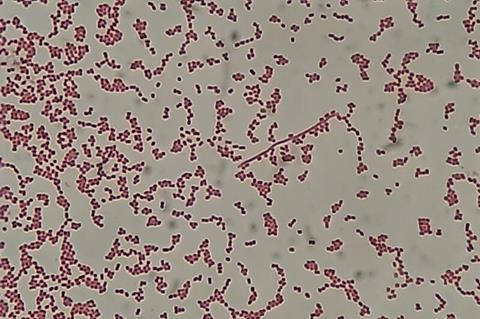Researchers have developed a strategy to identify new antimicrobial drugs with therapeutic promise from bacterial datasets, providing clues for discovering alternatives to traditional antibiotics.

The study, published as a Reviewed Preprint in eLife, represents a valuable new strategy for identifying novel lysins (enzymes produced by phages during infection) with antimicrobial activity, according to the editors. They describe the strength of evidence as solid for the therapeutic potential of two such lysins discovered during the study – PHAb10 and PHAb11. They add that the findings will be of general interest to microbiologists to explore in more detail.
READ MORE: Drugs pipeline rife with strategies to combat MRSA
READ MORE: Plant bacteria deploy phage elements to wipe out the competition
Antibiotic resistance, where microorganisms that cause disease evolve to survive the treatments that once killed them, represents a global public health concern. The overuse of antimicrobial agents in humans, livestock and industrial agriculture is the main reason for the spread and accumulation of this resistance.
Promising alternative
“Lysins, which are derived from phages – viruses that infect and replicate within bacteria – have antimicrobial effects and are considered to be a promising alternative to antibiotics, due to their low risk of resistance and the unique way in which they work,” says lead author Li Zhang, a PhD candidate at the National Key Laboratory of Agricultural Microbiology, Huazhong Agricultural University, Wuhan, China. “However, the discovery of lysins to treat infections is hampered by a limited amount of published phage genome data.”
Recent studies on lysins have linked their antimicrobial activity to their internal peptides – short chains of up to 50 amino acids with antimicrobial peptide-like architecture. This led Zhang and colleagues to see if they could identify new lysins with antimicrobial activity by scanning datasets of bacterial proteomes – that is, the entire set of proteins expressed by the genome in bacteria – rather than the genomes themselves.
Antimicrobial peptide
The team used P307, a well-documented antimicrobial peptide, as a template to search for new antimicrobial lysins in the proteome database for the bacteria Acinetobacter baumannii (A. baumannii). This database is publicly available from the National Center for Biotechnology Information. The work uncovered five new lysins with antimicrobial potential: PHAb7–11. In particular, PHAb10 and PHAb11 showed the most promise from the team’s initial tests.
To evaluate the antimicrobial activity of the five lysins, the team chemically synthesised their gene-coding sequences and expressed them in Escherichia coli (E. coli) cells. They then tested their activity against three species of bacteria: A. baumannii, P. aeruginosa and E. coli. This revealed that, even at low concentrations, the lysins had high antibacterial activity.
Differing conditions
The next step was to evaluate the antibacterial activity of PHAb10 and PHAb11 under different conditions. Previous reports have shown that lysins perform differently against bacteria in the exponential and stationary life phase.
In the stationary phase, bacterial reproduction and growth levels off as resources become limited, while in the exponential phase, bacteria rapidly multiply when there are plenty of resources and optimal conditions.
For PHAb10 and PHAb11, the team observed robust antibacterial activity against six different cultures of bacteria, in both the stationary and exponential phases. Importantly, these lysins were effective regardless of whether the bacterial cultures were resistant to traditional antibiotics or not.
Effect of heat treatment
The team also discovered that both PHAb10 and PHAb11 retained significant antibacterial activity after heat treatment at 100℃ for one hour, unlike PHAb7, PHAb8 and PHAb9, which lost their effect under these conditions.
To understand the thermostability of PHAb10, the team used X-ray crystallography to glean an insight into its crystal structure. They discovered that PHAb10 underwent a folding-refolding process during heat treatment, where dimeric units of its structure pair off under heat stress to increase stability and return to dimeric units when cooling. This switching is mediated by seven pairs of intermolecular interactions and is somewhat similar to the opening and closing of a zipper.
Finally, the team tested PHAb10 against two mouse models of bacterial infection, finding that it safely and efficiently cleared the bacterial infection and therefore demonstrated its therapeutic potential.
Live/dead assay
eLife’s reviewers have emphasised the need for further tests to improve the robustness of the team’s findings, such as a live/dead assay – a method that uses fluorescent dyes to differentiate between live and dead bacterial cells. This would provide greater insight into how effectively the lysins kill bacteria.
“Our work demonstrates that daily updated big data, such as bacterial genomes and proteomes, could be a crucial tool in the fight against antibiotic resistance,” says senior author Hang Yang, a professor at the Key Laboratory of Virology and Biosafety, Wuhan Institute of Virology, Chinese Academy of Sciences, Wuhan, China.
“We used our screening strategy to successfully identify new antimicrobial lysins with therapeutic promise. PHAb10 and PHAb11 are highly thermostable lysins, with a broad spectrum of antimicrobial action. If future studies validate our findings, these lysins could be explored further as potential therapeutic treatments.”







No comments yet